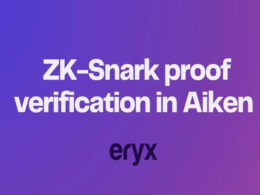Oxen is a layer one blockchain which was forked from Monero, originally called Loki. Making it a privacy focused network bootstrapping the same features such as ring signatures, stealth addresses, and ring confidential transactions. Unlike Monero which is a Proof-of-Work chain, Oxen operates with a Proof-of-Stake consensus algorithm called Pulse. Thus, the blockchain is maintained by a distributed network of community operated nodes, called service nodes. These nodes not only secure the blockchain and validate transactions but they also make it possible to run applications such as Session private messaging app and Lokinet a privacy focused internet browser.
The project’s whitepaper was published on July 13th, 2018 under the name of Loki. The authors are Kee Jefferys, Simon Harman, Johnathan Ross, Paul McLean. However, in this first iteration the whitepaper describes a hybrid Proof-of-Work / Proof-of-Service algorithm resistant to ASIC mining. Their reasoning for forking the Monero code was that transactions require significant bandwidth, processing, and disk space which doesn’t make the blockchain scalable. Their solution to this problem is a node reward scheme, called Service Nodes, which provides economic incentives for running them.
Pulse: PoS Consensus Algorithm
On October 15th, 2019 only a little over a year after launch, the project moved from Proof-of-Work (PoW) to Proof-of-Stake (PoS) under a new consensus algorithm called Pulse. This structural change was first presented to the community on the Loki Improvement Proposal (LIP) number five. Since Monero is an evolution on the CryptoNote protocol, which uses ring signatures, stealth addresses, and RingCT, giving users the ability to sign transactions and obfuscate amounts while maintaining plausible deniability, this makes Oxen the first Proof-of-Stake blockchain to provide these privacy focused functionalities.
The Pulse consensus algorithm randomly chooses an active service node every 2 minutes to create and publish new blocks of transactions to the blockchain, this is called the candidate block. Afterwards, a set of 11 random nodes are chosen to validate the new block, checking that no malicious activity has taken place. If 7 of the 11 validators verify the block’s legitimacy, it can be published to the network as a valid block. Once the validation is complete and the legitimacy of the block has been verified, it’s added to the chain. The Oxen network has an additional level of protection called checkpointing. Every four blocks, the blockchain takes a snapshot of every block in the chain, no transaction older than 2 checkpoints or 8 blocks can ever be changed. This means a transaction finality of approximately 16 minutes.
One of the main reasons for the move to PoS lies in the increased cost of an attack against the blockchain. Under the PoW consensus algorithm, a malicious actor would need to accumulate and control 51% of the hash rate to be able to double spend and reverse previous transactions. Since the PoW algorithm was optimized for CPU mining over GPU or ASIC, this means a wealthy attacker would be able to take control easier by just investing around under a million dollars on Ryzen CPUs. This also means a big enough actor could buy CPUs in bulk and get a wholesale price discount making the attack cheaper.
On the other hand, at the time of writing this article, there are 63.8 million $OXEN tokens in circulation with a current market value 9 cents the market cap stands at $5.8 million dollars. To be able to take control in a PoS chain the attacker needs to control 51% of the stake, that means almost $3 million dollars currently. This shows that an attack on PoS tends to be more expensive for an attacker than a PoW one. At least in this case of a small cap blockchain that was optimized for mining with CPU. It’s also important to remember that if the attacker starts buying big amounts of $OXEN tokens in a small period of time, the increased demand would take the price higher, making the overall attack much more expensive.
Another reason for changing the consensus algorithm is the power consumption of PoW, which is a known issue, although supporters of this system say that the energy is not wasted instead is the reason for its security. Be it as it may, PoS is far more energy efficient because there are no miners competing for a random number instead the service nodes cooperate to maintain the consensus and security of the network.
Oxen Service Nodes
Currently, there are 1729 OXEN service nodes actively securing the network. These nodes will create blocks every two minutes and receive a reward for doing so. Ninety-five percent of these rewards go to the service node stakers and the remaining five percent goes to Oxen Privacy Tech Foundation (OPTF). This is the NGO behind the development of the Oxen ecosystem, funding new features and implementations for privacy tools such as Session, Lokinet and of course the Oxen blockchain.
The current minimum requirement of $OXEN to run a service node is 15,000 which has a current market value of $1,372 USD. However, it’s possible to set up a shared or pooled service node for up to ten different contributors. The operator of the node will need to pledge a minimum of 3,750 $OXEN while the contributors will need to deposit 1,250 of their tokens. The operator of the node also has the ability to set a fee between zero and one hundred percent. The operator receives this fee before the reward distribution among all contributors. These can either be closed or open pools. A closed pool is a service node similar to a private stake pool in Cardano, where the seats for contributors have been reserved for specific wallets. Where thus an open pool is one that any user can deposit their tokens to help it reach the required minimum. These are great alternatives for people that individually don’t have the required fifteen thousand tokens but can still participate.
Unlike Cardano which enjoys liquid staking and $ADA can be moved and spent at any time even when staking, in Oxen there are locking periods. An operator will have to wait fifteen days or 10,800 blocks for their staked $OXEN to be made available. However, a node that is undergoing a deregistration will have to wait 30 days or 21,600 blocks for the funds to be made available.
A service node in Oxen first starts as a full node of the network, this means the node has the full history of the blockchain and doesn’t rely on third parties to store and process transactions. A full node becomes a service node once the owner locks the required amount of $OXEN, as explained before. Once accepted by the network, the service node starts performing operations and becomes eligible to receive periodic block rewards. As well as processing transactions and creating blocks, the service nodes provide services for the ecosystem privacy tools, such as Session and Lokinet. They receive, store and forward encrypted Session messages. Route Lokinet traffic and are called into quorums that give them authority over Blink transactions. These are instant payment transactions from Oxen.
Running an Oxen full or service node is quite accessible for their hardware requirements as shown below. For more information on how to run your own node, refer to the official guide.

Blink: Instant transactions
Blink is an instant payment transaction with $OXEN made possible by two randomly-selected groups of ten Oxen service nodes. These nodes check the legitimacy of the transaction before it reaches the mempool. Malicious or invalid transactions are denied by the quorums that check to make sure the transaction doesn’t cause any issues to the chain. Once the valid transaction is confirmed by the quorums, sender and receiver receive the transaction confirmation. Afterwards, the transaction reaches the mempool waiting to be added to the blockchain but it has already been preventively confirmed by twenty random nodes. This is the first and only instant payment solution for a CryptoNote-based privacy coin. This makes it possible to provide a viable solution for privacy-conscious point-of-sale applications in the real world.
Tokenomics
Oxen is run by a decentralized network of incentivised nodes that validate transactions and create blocks securing the blockchain without a centralized authority. To do so, there must be an incentive that will make an individual want to dedicate time, money and resources on this endeavor. Each Oxen block contains 16.5 $OXEN that is paid to the service node. This results in the creation of 11,880 $OXEN per day. On the other hand, the Oxen Privacy Tech Foundation (OPTF) receives a governance reward of 9,240 $OXEN every seven days. This payment is dedicated to development, marketing and community projects.
Since $OXEN doesn’t have a supply limit, it solves the problem of inflation (i.e. new coins entering the market and devaluing its purchase power) with a token burning mechanism. This is a legit mechanism to keep the network healthy and the economic incentives in place for service node operators to get rewarded for their work. However, we have also seen a lot of dubious projects abuse this mechanic to manipulate the price of their token. So it’s important to understand the whole picture before making a judgment regarding a specific mechanic in tokenomics.

Through a robust token burning mechanism, Oxen manages to keep the effective net emissions low. At the time of writing this article, there are 63 million $OXEN in circulation and 738 thousand have been burned so far. For a simple blink transaction, the fees are around 0.101 $OXEN from that 40% goes to the service node that constructed the block validating the transaction and the remaining 60% or 0.06 $OXEN is burned. The Oxen foundation periodically reevaluates and adjusts fees and burn amounts to maintain reasonable levels relative to the price of $OXEN.
Conclusion
As an advocate of privacy, anonymity, sovereignty and decentralization I love to discover new projects trying new things and providing value for their users. I originally found Oxen thanks to Liberlion who recommended that I try Session, the privacy focused messaging app that runs on top of Oxen. I went down the rabbit hole of learning how this blockchain works and the technical decisions they had to make to create a robust platform that can run privacy focused services without sacrificing decentralization or security. Being a PoS fork of Monero makes it a very interesting project to keep in our radar. Blink instant transactions is already a new innovation made possible by the switch from PoW to PoS. I’m personally looking forward to what other inventions the Oxen foundation has prepared for us under their sleeves.









